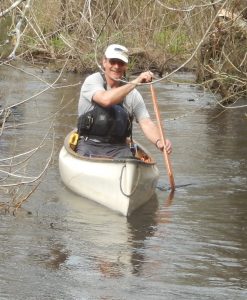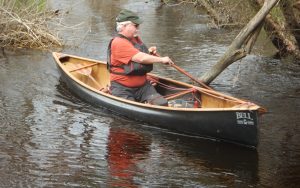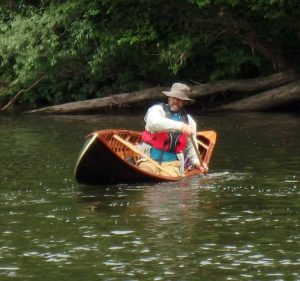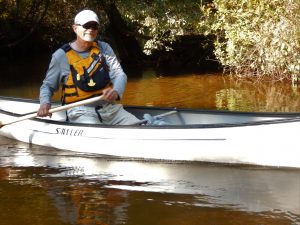By Tim Burris

Why Kneel?
In my last article, we discussed different things to make kneeling more comfortable for people who have had bad experiences. In this article I’ll talk about some of the advantages to kneeling in a canoe.
For me, comfort is near the top of the reasons why kneeling is preferable. I have lower back issues from a life of heavy lifting. It is simply more comfortable to kneel than to sit on a standard canoe seat for me. I can only sit low in a pack canoe or kayak for an hour, but I can kneel in a canoe comfortably for much longer.
Control
 While resting on the seat with your knees in the chines of a canoe, you have a significantly enhanced measure of control. In a kneeling stance it is far easier to shift your weight. Students often have a hard time thinking about weight shifts, but we cannot walk without shifting weight from one foot to the other. Think how you carve curves on skis. In skiing, if you want one ski to bite in, you take weight off of your other foot and that weight has to be transferred to the other ski. The same is true when kneeling in the canoe. Take weight off one knee and it transfers to the other knee and the canoe begins to carve the turn. Plus, your other knee is free to move around. Shift your weight to the seat and you can more easily reposition both knees.
While resting on the seat with your knees in the chines of a canoe, you have a significantly enhanced measure of control. In a kneeling stance it is far easier to shift your weight. Students often have a hard time thinking about weight shifts, but we cannot walk without shifting weight from one foot to the other. Think how you carve curves on skis. In skiing, if you want one ski to bite in, you take weight off of your other foot and that weight has to be transferred to the other ski. The same is true when kneeling in the canoe. Take weight off one knee and it transfers to the other knee and the canoe begins to carve the turn. Plus, your other knee is free to move around. Shift your weight to the seat and you can more easily reposition both knees.
We call it “pitching” when we shift our weight from the seat onto our knees. (See “A Pitch for Heeling Part 2”: https://freestylecanoeing.com/a-pitch-for-heeling-part-2/ ) Our weight is now several inches in front of the seat. It pushes the bow down into the water while the stern rises out of the water and swings around much more easily. This increases the speed of a turn, which is a useful trick for hairpins. Can you shift weight to one knee while you are pitching? Yep!
In rough water and rolling waves kneeling can save the day. Having the ability to shift weight from one knee to the other in sync with the rolling of the waves can help keep your canoe on a more even keel. It has been ages since I water skied, but in crossing the tow-boat’s wake one “steps” over the wake-waves by shifting one’s weight from one ski to the other, and the concept here is similar. This is a lot harder to do when you are sitting on the canoe seat with your legs out in front of you.
 When kneeling, your thighs in effect become “struts” which you can use to shift weight more easily from side to side. This lateral stability is where the improvement in control happens. When sitting, you have no such tool at your disposal.
When kneeling, your thighs in effect become “struts” which you can use to shift weight more easily from side to side. This lateral stability is where the improvement in control happens. When sitting, you have no such tool at your disposal.
Movement
We just talked about weight shifts that help with control. Kneeling allows you to move around in your boat using those weight shifts. With a little practice, you can turn your whole body up to 90 degrees so that you are facing your paddling side. So, you are doing a little less torso rotation and you can talk to the person paddling beside you.
Again, when you put weight on one knee and your seat, the other knee is free to move. By using alternating weight shifts, you can move your knees with little “baby steps” from one side to another.
Offside paddle placements and strokes are much easier when you are facing the offside of the canoe. Torso rotation is great, but “facing your work” is easier.
Finally, being able to move around in your canoe means you can shift around for comfort. Let the blood flow into your legs by shifting all your weight onto the seat for a short time. If your butt falls asleep, you shift onto your knees.
Kneeling gives you a lot more options for movement than sitting.

Paddle Reach
The attack angle of your paddle is more effective when you are kneeling than sitting. Bent angle paddles have their place, but watch sprint canoeists paddle on one knee and see real power.
Seeing
In a canoe, my eyes are higher above the water when I’m kneeling versus sitting. And when I go up on both knees they are even higher. I can see farther when I kneel than when I sit and it’s easier to read the river ahead. It is also a better angle to see into the water when kneeling. That is great for watching turtles and fish under the surface. But it is also better for judging the depth of the shallows while I’m paddling and that keeps me from running aground. I personally think I see more wildlife because I kneel in my canoe. Kneeling also allows me to easily turn around to look behind me.
Getting In and Out
There are lots of videos of people rolling out of their pack canoes and into the water. I won’t lie, after a couple hours of kneeling it takes a minute for my ankles to “wake up”. It is still easier to pull my feet out from under the seat and step out of my boat from a kneeling position that from a sitting position. If you paddle a creek with a lot of beaver dams and blowdowns, getting in and out is something you do often.
These are just a few of the reasons I can think of for preferring kneeling in a canoe over sitting. Kneeling isn’t for everyone, but for me the advantages are many and it makes me a better paddler.